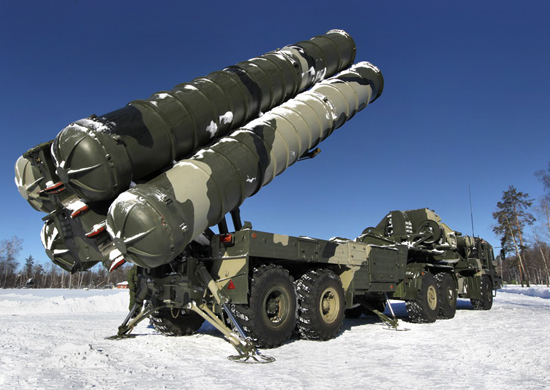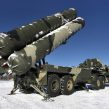
Russia Reforms Aerospace Defense Structures—Again
Publication: Eurasia Daily Monitor Volume: 12 Issue: 151
By:

Moscow has implemented another step toward improving and consolidating its conventional military force capabilities by creating an entirely new arm of service: the Aerospace Forces (Vozdushno Kosmicheskikh Sil—VKS). The Aerospace Forces became functional on August 1, concluding several years of planning by the top brass and senior Russian defense planners to merge the Aerospace Defense Forces with the Air Force. The roots of such reforms are not new; they are linked to military modernization and integrating existing commands while reflecting anxiety about possible surprise enemy air and space attacks against the state (TvZvezda, August 3).
On August 3, Defense Minister Sergei Shoigu commented on the formation of the new arm of service. Shoigu justified this development by stating that it is “prompted by a shift in the center of gravity of the armed struggle toward the aerospace sphere.” The new structure was thus described as the “optimal option” for improving the country’s aerospace defense. Shoigu elaborated this, saying that the Aerospace Forces combines the Air Force (Voyenno-Vozdushnye Sily—VVS) with the (Vozdushno Kosmicheskaya Oborona—VKO). “Now the single command unites aviation, air defense and anti-missile defense troops, space forces and means of the armed forces,” Shoigu said, adding, “This makes it possible, in the first place, to concentrate in a single command the entire responsibility for formulating military and technical policy for the development of troops dealing with tasks in the aerospace sphere and, secondly, to raise the efficiency of their use through closer integration and, thirdly, to ensure the consistent development of the country’s aerospace defense” (TASS, August 3).
VVS commander, Colonel-General Viktor Bondarev, was appointed as the commander-in-chief of the VKS; Lieutenant-General Pavel Kurachenko as chief of the Main Staff and first deputy commander-in-chief of the VKS; and Lieutenant-General Alexander Golovko as its deputy commander-in-chief and commander of the Space Forces. “General command of aerospace defense will continue to be exercised by the General Staff and directly by the main command of the Aerospace Forces,” Shoigu said (TASS, August 3).
Moscow-based military analysts commented on the drivers behind creating the VKS and speculated on the overall merit of the move. Maxim Shepovalenko, an expert at the Center for the Analysis of Strategies and Technologies (CAST) said the VKS reflects lessons drawn following the North Atlantic Treaty Organization’s (NATO) intervention in Yugoslavia, in 1999. “Based on what we saw [then], air and space attacks are the first stage of any conflict, be they small, medium or large,” Shepovalenko said, adding that the “prime reason for the merger is to ensure a prompt response to any attack coming from the air or space with a streamlined and unified command.” Modern militaries, in his view, see air and space as seamless parts of the theater of warfare, and the United States, China and also Russia are working on systems capable of bringing war into space, which compels the development of new defensive strategies. On the other hand, Aleksandr Golts, in Yezhednevny Zhurnal, argued that the idea of such innovation had long been voiced, with Sergei Ivanov mooting the concept in 2006. Golts suggests the main “advance” would be the benefits for the generals receiving posts in the new structure (Yezhednevny Zhurnal, August 4; The Moscow Times, August 3).
The CAST analysis seems to be closer to the mark than the representation of the creation of the VKS as merely another example in a long line of Russian military musical chairs. The key to unpicking these elements lie in the reform in 2010–2011, which resulted in the formation of the VKO: establishing the context and parameters for the latest initiative, and revealing a critical conceptual difference alongside inter-service rivalries. Some of the features of the planning to form the VKO in this period bear similarity to recent statements by the defense ministry leadership. Indeed, in the spring of 2011, as VKO planning entered its final stages, the then–chief of the General Staff, Army-General Nikolai Makarov, said the new structure would serve as an umbrella covering Russia against attack by ballistic missiles, medium-range missiles and various cruise missile platforms; with this in mind, he promised the branch of service would receive S-400s and the S-500s, under development, to form the equipment basis for the VKO. In 2011, prior to formally creating the new VKO, speculation had mounted that the VVS could lose out in the reform. However, by December 1, 2011, with the new VKO up-and-running, it was clear that the VVS maintained its position as an arm (vid) of service, rather than as a branch (rod); but the relationship between the VVS and the VKO was left unclear. Moreover, sources close to the reform saw the VKO’s creation as a series of stages, with the first, in 2011–2016, unifying the Space Troops and Air Defense assets from various branches and arms of service (see EDM, November 1, 2011). This seems to have been completed ahead of schedule.
It is therefore, crucial to note that, unlike the earlier iteration of the move to unite air and space assets under a single command, President Vladimir Putin’s August 1 decree specifically establishes the Aerospace Forces (VKS) as a full-fledged arm (vid) of service, as opposed to a mere branch (rod) (such as the elite Airborne Forces). As such, this means the VKS will be afforded the same level of importance in its modernization and future procurement needs as the Army or Navy. However, since the VKS will be highly demanding in the area of high-technology assets, it is possible that the Army will emerge from its modernization as the “poor cousin” of the other service arms. Equally, the choice of Bondarev as its commander implies that the VVS has fought its service corner adequately and will retain influence in the decision-making and further refining of the VKS concept (TvZvezda, August 3).
Finally, the Russian military is no stranger to fearing a sudden surprise armed assault on the country led by an air campaign; the institutional and military cultural legacy of June 1941 is strong, and more recent Russian military analysis pays much attention to the NATO bombing of Serbia in 1999 as influencing defense planning. It appears, also, that the VKS is part of an effort to unite air and space into one concept, but this is far from new in Russian thinking. Nonetheless, the strategic message to other actors is abundantly clear: Moscow wants to send a signal that Russia is neither Serbia, nor Libya.




